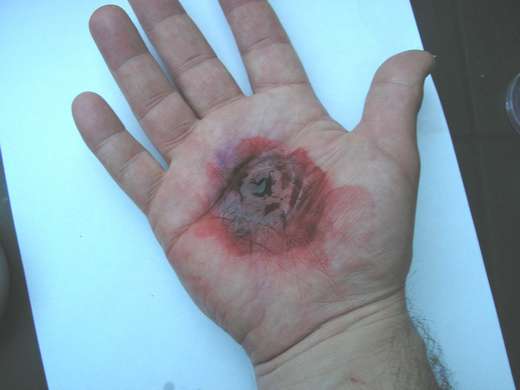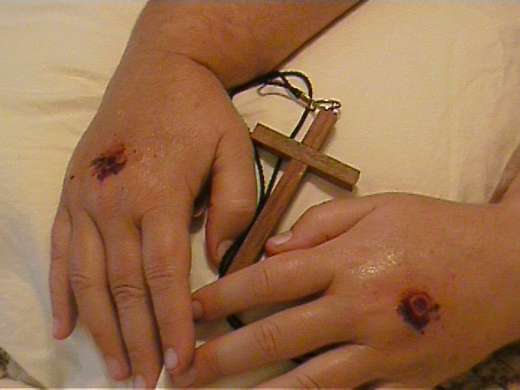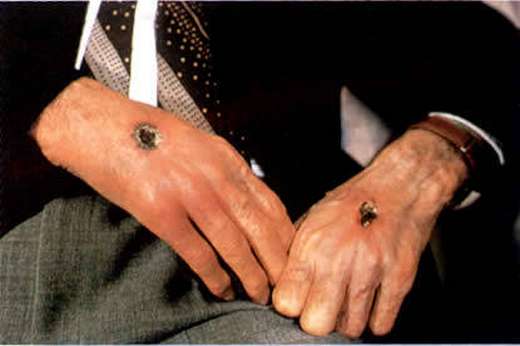Mysteries of Stigmata
Most people have at least heard of stigmata even if they are not entirely sure what it is since the word is casually tossed around on occasion and was even turned into a thriller movie during the late 1990s. However, the question of what it actually is other than bleeding in seemingly random places along the body with no obviously visible reason like a cut or stabbing by a knife. Let us take a look into the mystery that is the stigmata and see if we can find a place for it in our modern world.
Stigmata (singular stigma) are bodily marks, sores, or sensations of pain in locations corresponding to the crucifixion wounds of Jesus, such as the hands and feet. In some cases, rope marks on the wrists have accompanied the wounds on the hands.
The term originates from the line at the end of Saint Paul’s Letter to the Galatians where he says, “I bear on my body the marks of Jesus.” Stigmata is the plural of the Greek word st??µa stigma, meaning a mark or brand such as might have been used for identification of an animal or slave. An individual bearing stigmata is referred to as a stigmatic or a stigmatist.
Stigmata are primarily associated with the Roman Catholic faith. Many reported stigmatics are members of Catholic religious orders. St. Francis of Assisi was the first recorded stigmatic in Christian history. For over fifty years Padre Pio of Pietrelcina reported stigmata which were studied by several 20th century physicians, whose independence from the Church is not known. The observations were reportedly unexplainable and the wounds never became infected.

What is it ?
Strictly speaking, stigmata are marks on someones body that correspond to the crucifixion wounds of Jesus as stated in Christianitys biblewith particular emphasis on marks that occur on the persons hands or feet. Stigmata is actually the plural form of a Greek word stigma which literally translates as a brand or mark that was used in the identification of a domesticated animal or slave. The word stigmata as applied to marks or wounds associated with those of Jesus actually comes from Pauls letter to the Galatians at the end line of the writing where he stays that he bears on (his) body the marks of Jesus. The reported cases of stigmata show some, a few, or all five of the holy wounds that were inflicted on Jesus according to writing of his crucifixion in the bible, which include a wound in the side of a torso from a lance and ones in the hands and feet from nails.
Occasionally, the wounds associated with Jesuss torture before the actual crucifixion such as the crown of thorns or back lacerations have been associated with stigmata as well. In some claims of the odd happening, the stigmatics declare extreme pain accompany the wounds. Sometimes though people claim to experience the pain of stigmata like wounds without any visible wounds on the outside of the body. These cases are referred to as invisible stigmata. However, a portion of people who have stigmata have wounds that appear to not clot while staying uninfected and fresh. A handful of cases even declare that the blood from the wounds has a pleasant or perfume type odor which is generally referred to as the Odor of Sanctity. The causes of this strange occurrence tends to vary from case to case when investigated by doctors, scientists, or religious officials. However, stigmata is mainly associated with the Roman Catholic faith and most of the reported stigmatics generally are participants of Catholic religious orders
Scientific Research into Stigmata

Famous Cases of Stigmata
The first specifically recorded incident of Christian stigmata was Saint Francis of Assisi. Two years before his death in 1224, he set off on a journey to Mount La Verna in order to fast for forty days. As Francis prayed one morning near the celebration time of the Exaltation of the Cross, an angel reportedly came to his side. Francis was able to see that the angel was crucified as he came closer. Upon seeing the form of the crucified angel, Francis was humbled by the vision while his heart filled with great elation for being specially chosen for an angelic visit and both saddened as well as put through great pain at the horror of seeing a mutilated angel. Once the angel left Franciss presence, he reportedly had wounds in his feet, hands, and side as though he had been pierced by the same lance that had been driven into Christs side. An image of nails appeared in his hands and feet right away, and his side wound frequently seeped out blood. The first biographer of Saint Francis of Assisi, Thomas of Celano, reported the entire incident in his 1230 publication entitled The Life of Saint Francis. However, modern doctors have looked back on the symptoms of Saint Francis to report he most likely had quartan malaria with the complication of purpuraa purple hemorrhage of blood into the skin which could have easily been punctured in the wilderness to appear as an open wound similar to those of Christ.

THE STIGMATICS
One of the first recorded Stigmatics was St Francis of Assisi. Coming from a wealthy family, he was an adventurer. However, in 1202 he was taken prisoner, the experience causing illness. From this point on he changed, eventually having a religious experience and publicly stripping himself, thus denying material things.
In 1224 he founded the Franciscan Order and shortly afterwards he had another vision on the slopes of Mt Alvernia. He began to bleed, then, from the wounds of Christ, and bled continually for the last two years of his life.
Early SPR member Eric Dingwall studied cases of Stigmata such as that of St Mary Magdalen de Pazzi who became a Stigmatic in 1585 after much religious devotion. Dingwall concluded that it was nothing more than self mutilation, caused by the masochistic attitudes of early religious devotion.
However, when we consider the case of Padre Pio who bled continually from 1918 to his death in 1968, we must doubt the most fanatical masochism as the cause.
TOWARDS UNDERSTANDING
In 1972, ten year old Cloretta Robertson from Oakland, California, became a Stigmatic after watching a film about the crucifixion. Not particularly religious, Cloretta shows that we may not be dealing with religious devotion at all.
This becomes clear from the case of Elisabeth K, a psychiatric patient looked after by a Dr Albert Lechler in 1932. After watching slides of the crucifixion, she began to feel tingling effects at the traditional sites of the wounds of Christ. Hypnotising her, the doctor suggested wounds at these points, which duly appeared.
This suggests the idea that Stigmata is a replication of Christs wounds is unlikely. Evidence suggests people were nailed through the wrist during crucifixion, not the palms. Similarly, Stigmata seems to have begun when Church statuary first depicted crucifixion, giving a cultural stimuli.

What seems to be the guiding principle here is stress. Further, hypnosis can cause similar, if less severe, phenomena.
Researcher Ian Wilson feels Stigmata is self-induced by stressful sufferers who turn to prayer, causing multiple personality-type symptoms, from which the Stigmata comes. Indeed, Oscar Ratnoff of Cleveland, Ohio, investigated some sixty cases where emotional distress has caused inexplicable bleeding.
Just what causes Stigmata remains unclear. But one thing that is clear is that the ability to cause bodily scars by mind power is more common and observable than we think.
HYSTERIA
That hysteria is involved seems more than likely. Indeed, cases of hysterical blindness and paralysis are quite common, the mind having a definite effect on the body. Further evidence is offered by the placebo effect.
Here, it has been shown that a state of mind can have up to a 30% effect upon the severity, or not, of illness. As for bleeding itself, psychological states are known to have an effect upon menstruation.
Bodily blemishes, weals, and even sores can have a psychological foundation, with some cases of psoriosis being put down to stress. And if release is caused by, say, a reliance upon Christianity, it is easily possible for the result to be imitation of Christs wounds.
CULTURAL EFFECT
This shows a distinct cultural effect to the form psychologically induced body mutation can seem to take. And bearing this in mind, Stigmata can often be seen to be of benefit in other areas of phenomena.
For instance, the focus of a poltergeist infestation can often exhibit such bodily change, such as words appearing on the body as weals. Evidence for reincarnation often comes in the form of similar physical scaring to a previous life.
Perhaps most relevant to modern phenomena, some cases of alien abduction are said to include physical evidence, such as marks on the body. However, by inducing the possibility of known hysteria in Stigmata, we can maybe conclude that other forces may be involved forces from the inner mind rather than outer space.
Discuss article



